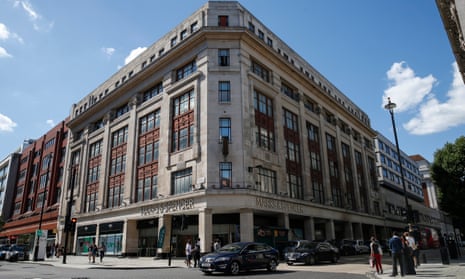A controversial decision by London’s mayor, Sadiq Khan, to allow the demolition of a flagship Marks & Spencer store on London’s Oxford Street is one of the highest-profile instances so far of what is certain to become a wider debate about embodied carbon. This crucial term, which refers to the carbon emissions of a building over its lifetime, urgently needs to be brought into wider circulation. In the UK, buildings are estimated to be responsible for 23% of all emissions.
With its millions of Victorian and Edwardian terraces, the UK has some of the oldest housing stock in the world. So the idea of a “throwaway building culture”, as Will Hurst of the Architects’ Journal describes our contemporary attitude to construction, takes some getting used to. But developers, particularly of large-scale projects, routinely look for a blank slate on which to place a new edifice. Demolition is part of what the construction industry does.
Emissions calculations are more complicated than in other sectors because of the role played by time. Arguments over the Marks & Spencer decision, and other proposed demolitions such as that of the fire-damaged Assembly Rooms in Derby, arise because short-term and long-term impacts have to be weighed along with other considerations. In environmental terms, the question comes down to whether the benefits of a new, energy-efficient building will offset the emissions of a demolition and construction project.
Recycling, refurbishing and retrofitting are the way forward, and architects and engineers have come up with some ingenious solutions. One block of flats in Copenhagen reused the brick walls of a brewery by cutting them into panels. But such innovative examples of reuse aside, Lord Deben, chairman of the UK’s Climate Change Committee, was right to say last year that “we have to learn to make do and mend” as an alternative to pulling down buildings as a matter of course.
Such a shift poses particular challenges in the dysfunctional UK, where property price inflation and rent extraction have, to a damaging extent, taken the place of economically productive activity. While the government has promised a new focus on embodied carbon, any shift in the approach taken by the construction industry will require economic incentives. Vague notions of corporate social responsibility will not cut it. Whole-life carbon assessments should form part of every planning process, with decision-makers empowered to reject schemes that do not meet strict standards. Changing the law to remove the tax advantage of new-builds over refurbishments is one obvious step.
The size of this undertaking should not be underestimated. But nothing about the struggle against global heating is easy. Like his support for the Silvertown tunnel, Mr Khan’s refusal to prevent the Marks & Spencer scheme sends a worrying signal. The challenge is to make such decisions, and the economic and political conditions that enable them, a thing of the past as quickly as possible.
